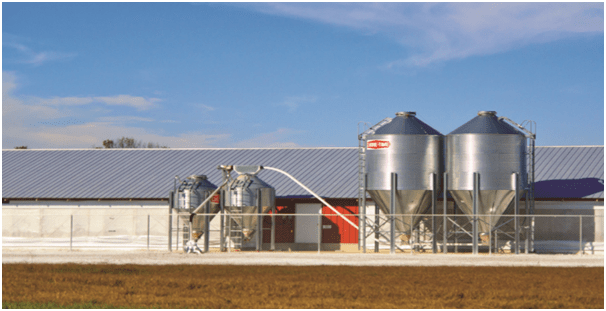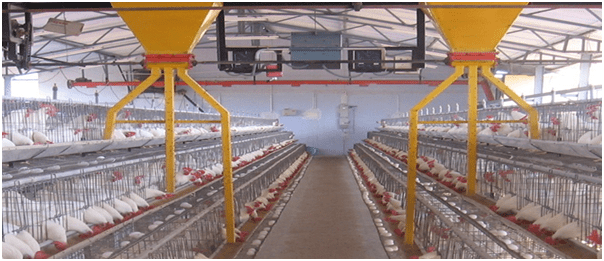Dr. S.K. Maini
The actual farm problems responsible for the in-efficiency, poor performance and financial losses are never discussed in any of the conferences, meetings and the farmers get together’s.

A well designed Feed Mixing Unit
Lot of thinking and investment goes into designing, construction, deciding equipment and machinery, their placements, testing and operations. Experts and specialists are involved at every step, during the construction period.
Once completed, the situation drastically changes, most on farm feed plants are handled by a supervisor, assisted by few labourers, who hardly think of anything except producing the feed for next 2 to 3 days, in all types of weather conditions, throughout the year. They are always under pressure to ensure that feed is available to all the age groups in every shed on the farm and associated farms, (chicks and grower units located elsewhere or other layer units ) on regular basis.
The problems, lies in the poorly designed feed plant building, ill-ventilated, very rarely cleaned, full of dust and cobwebs, free flying birds, variety of rodents and insects etc., that are always present and continue the damage, already done by the fungus to the ingredients before they reached the feed plant storage area, to begin with.

Feed Silo’s or Bins outside the Poultry house with connecting Auger’s
The Auger’s carrying feed from the Storage Silo’s or Bins at the feed plant to the Shed Storage Silo’s or Bins, and from the Bins to the feed distribution trolleys inside the sheds and all connecting augers are never washed, cleaned and sanitised. There is no cleaning system in place for this very important farm activity.

Proper feed storage is required and is essential for good performance, the use of poor storage facilities will lead to deterioration of feed quality. Which in turn, will result in poor growth, malnutrition, health problems related to mycotoxins and possibly high mortality on the farms. All the above mentioned, decrease farm production, profitability and viability.
For best performance ensure the following are looked into on regular basis.
The storage facility and machinery ( Feed Plant Shed) : Feed needs to be properly protected therefore a feed storage facility/shed should meet the following criteria:
- Provide a safe shelter from direct sunlight and rain (No roof leakage, No wall and floor seepage).
- Be properly ventilated to keep dry and cool.
- Sweep clean the empty/vacant area, entry points, stairs and the area outside the entry points.
- Protect feed from Rodents (bandicoots/rats/mice – consider biological control methods) and insect pests.
- Keep the feed off the ground to prevent ground condensation and spoilage due to mould growth and mycotoxin formation, use pallets.
- Keep the chemicals (fertilisers) and drugs (insecticides and pesticides out of the feed storage area).
- White wash the inside walls of the feed storage area, once a year.
- Once a week – check the total plant and machinery for its functional fitness and production capability.
- Preventive maintenance be taken up on monthly basis, by oiling and greasing the movable parts, like gears, gear boxes and bearings. Done regularly reduces the breakdown time.
- Change the worn out grinder hammer blades as they affect the feed size and digestibility.
- Check the belts and chain drives, do the needful required.
- General cleaning and upkeep – wipe clean the immovable parts of the grinder, mixer, elevators and Auger’s.
- Check the weighing balance and scales for their accuracy, periodically get them serviced, validated and standardised.
- The bird feeders in the poultry sheds, where cakes form, need to be scrape cleaned regularly to prevent mould and mycotoxin formation.
Storage conditions : Poor storage will reduce the shelf-life of the feed through loss of critical nutrients, such as vitamins, essential fatty acids and anti-oxidants. This will lead to reduced growth and higher mortalities due to poor bird health, suppressed immunity and metabolic complications.
Feed subjected to wet storage conditions will become stale and mouldy. These moulds will grow and produce mycotoxins, which is particularly the case during wet and warm weather conditions or when newly harvested grains with higher than 14 % moisture are used. The use of mouldy feeds may lead to performance losses, vaccine failures, illnesses, and mass mortalities. Climate and weather also play an important role. The temperature and the relative humidity of the air can also have its influence on the keeping quality of the feed.
Even with good feed storage system and fair weather conditions, feed should be stored for a short period of time, ideally for less than 15 days from the date of the feed being manufactured. Quality of feed deteriorates with every passing day.
Temperature and Humidity: When storing feed in silo/bins placed outside the poultry shed, open to sky, one should realise that radiation from the sun during the day creates a greenhouse effect inside the silo/bin, where condensation takes place. Condensation not only increases the risk of mould forming on the top layer of the feed and along the inside of the silo/bin walls, but it may also cause bridging of the feed since it may stick on the silo/bin wall. Overheating can have a major impact on the nutritional value of the feed stored, in which case proteins may be broken down or fat may become rancid, Vitamins and trace minerals get oxidised/deteriorated, leading to in efficient type of feed, that is otherwise nutritionally well balanced.
Well maintained feed manufacturing units, consume less electricity, have less break down time, are more efficient and safe for both the birds and the workers, all leading to less tensions for the farm owners, less cost of maintenance and repairs, better overall performance and more profits.